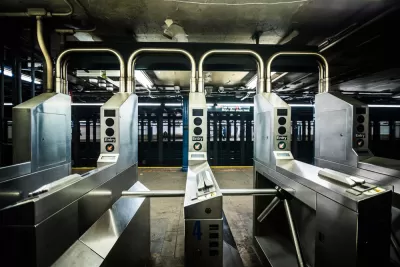In the continuing debate over congestion pricing in New York, Adele Peters asks if transit advocates are stopping short of what they should be asking for: free transit for all of New York.

It's been a rough year for the MTA. Between service failures and falling ridership, many are looking for a way to buoy public transit in New York. Some transit proponents have argued for congestion pricing, but Mayor Bill de Blasio continues to oppose the idea.
"But a report at the time, commissioned by mass transit advocate Theodore Kheel, suggested that a fee on drivers would not only reduce traffic and save the city billions by regaining the productivity of people previously stuck in gridlock, but would be able to pay for free public transportation for everyone else," Adele Peters writes for Fast Company. This is beyond what some have asked for. "The fees could help repair and upgrade the city’s struggling subway system. The idea of free public transit is less likely to ever happen," Peters writes. But that is what Mayor Bloomberg described wanting when he discussed the idea during his term.
For his part, de Blasio suggests funds for the MTA could come from a "millionaire's tax" that would subsidize transit passes for those who can’t afford tickets, Peters reports. But this system would do nothing to curb traffic or creates incentives for transit before the improvements can be made. Peters argues that transit's role will be just as important in the future: "Even if cars are shared, electric, and self-driving, subways and buses still have advantages, including keeping roads less congested. Cities will need to find ways to make those traditional services competitive, and that might eventually mean lower–or even free–fares."
FULL STORY: Should Public Transit Be Free?

Planetizen Federal Action Tracker
A weekly monitor of how Trump’s orders and actions are impacting planners and planning in America.

Map: Where Senate Republicans Want to Sell Your Public Lands
For public land advocates, the Senate Republicans’ proposal to sell millions of acres of public land in the West is “the biggest fight of their careers.”

Restaurant Patios Were a Pandemic Win — Why Were They so Hard to Keep?
Social distancing requirements and changes in travel patterns prompted cities to pilot new uses for street and sidewalk space. Then it got complicated.

Albuquerque Route 66 Motels Become Affordable Housing
A $4 million city fund is incentivizing developers to breathe new life into derelict midcentury motels.

DC Area County Eliminates Bus Fares
Montgomery County joins a growing trend of making transit free.

Platform Pilsner: Vancouver Transit Agency Releases... a Beer?
TransLink will receive a portion of every sale of the four-pack.
Urban Design for Planners 1: Software Tools
This six-course series explores essential urban design concepts using open source software and equips planners with the tools they need to participate fully in the urban design process.
Planning for Universal Design
Learn the tools for implementing Universal Design in planning regulations.
Heyer Gruel & Associates PA
JM Goldson LLC
Custer County Colorado
City of Camden Redevelopment Agency
City of Astoria
Transportation Research & Education Center (TREC) at Portland State University
Camden Redevelopment Agency
City of Claremont
Municipality of Princeton (NJ)




























